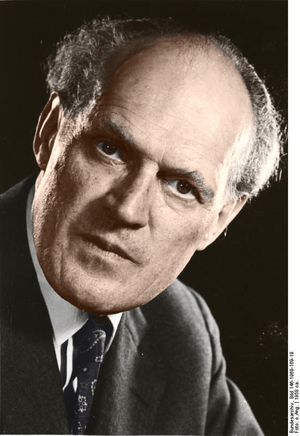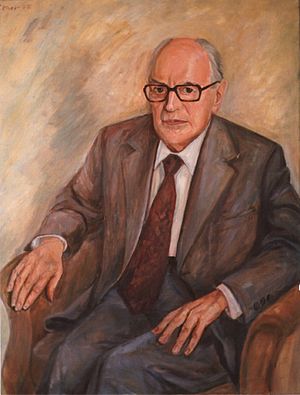Willy Messerschmitt facts for kids
Quick facts for kids
Wilhelm Emil Messerschmitt
|
|
|---|---|

Messerschmitt in 1958
|
|
| Born | 26 June 1898 |
| Died | 15 September 1978 (aged 80) |
| Nationality | German |
| Education | Munich Institute of Technology |
| Occupation | Aerospace engineer |
Wilhelm Emil "Willy" Messerschmitt (born June 26, 1898 – died September 15, 1978) was a famous German aircraft designer. He created many important planes, including the Messerschmitt Bf 109. This fighter plane became very important for Germany's air force, the Luftwaffe, before and during World War II.
The Bf 109 is one of the most produced warplanes ever, with about 34,000 built. Only the Soviet Ilyushin Il-2 had more. Messerschmitt's company also built the Messerschmitt Me 262, which was the first jet-powered fighter plane to be used in battle.
Contents
Early Life and First Designs
Willy Messerschmitt was born in Frankfurt am Main, Germany. His father was Baptist Ferdinand Messerschmitt, and his mother was Anna Maria Schaller.
Learning to Design Planes
When he was young, Messerschmitt became friends with Friedrich Harth. Harth was a pioneer in designing sailplanes, which are aircraft that fly without an engine, using air currents.
In 1914, Harth joined the German army. While he was away, Messerschmitt continued working on one of Harth's glider designs, called the S5. In 1917, Messerschmitt also joined the military.
Working Together on Gliders
After the war, Messerschmitt and Harth met again. They continued to work on aircraft designs. Messerschmitt started studying at the Munich Technical College. At the same time, Harth built planes at the Bayerische Flugzeugwerke (BFW), which means Bavarian Aircraft Works.
In 1921, they designed and built the S8 glider. This glider set an unofficial world record for how long it could stay in the air. For a while, they even ran a flying school together. In the same year, Messerschmitt designed his first plane completely by himself, the S9 glider.
Starting His Own Aircraft Company
In 1923, Messerschmitt finished his studies at the Munich Institute of Technology. Soon after, he and Harth decided to go their separate ways. Messerschmitt then started his own aircraft company in Augsburg.
At first, his company built only sailplanes. But within two years, he began designing small planes with engines. These included sports and touring aircraft. His designs, like the Messerschmitt M 17 and Messerschmitt M 18, were successful.
Challenges and Setbacks
In 1927, Messerschmitt sold his designs to BFW. The government encouraged his company to merge with BFW. After this, he designed the Messerschmitt M20 light transport plane in 1928. However, this plane caused big problems for BFW and Messerschmitt.
Two M20 planes owned by the airline Deutsche Luft Hansa crashed soon after they were bought. Because of this, the airline canceled their order for more M20s. This caused serious money problems for the company, and it went bankrupt in 1931. The crashes also created a powerful opponent for Messerschmitt in Erhard Milch, the head of Luft Hansa.
Designing for Germany's Air Force
Despite the challenges, Messerschmitt had connections with important government officials. These connections helped him stay in business. When the Reichsluftfahrtministerium (German Air Ministry) was created in 1933, it led to a new start for the German aircraft industry and for BFW.
New Aircraft Designs
Working with Robert Lusser, Messerschmitt designed a new important plane for the relaunched company. This was a low-wing, four-seater plane called the Messerschmitt M37, later known as the Bf 108.
The next year, Messerschmitt used many of the advanced features from the Bf 108 to design the Messerschmitt Bf 109 fighter plane.

In 1936, the Bf 109 won a competition for single-seat fighter planes. It became one of the main aircraft used by the Luftwaffe. This made Messerschmitt and his factory very important for Germany's plans to build up its air force. His role grew even more when the Messerschmitt Bf 110 also won a competition for a multi-purpose fighter plane.
On July 11, 1938, Messerschmitt became the chairman and managing director of BFW. The company was then renamed Messerschmitt AG. In the same year, the company began working on what would become the Me 262, the first jet-powered fighter. They also started on the Messerschmitt Me 210, which was meant to replace the Bf 110. The Me 210 had many problems during its development, which were only solved by changing it into the Messerschmitt Me 410.
After World War II
After World War II, Germany was not allowed to build aircraft until 1955. Because of this, Willy Messerschmitt's company started making other things. They built prefabricated buildings (buildings made in sections), sewing machines, and small cars. One of their most famous cars was the Messerschmitt Kabinenroller, a unique three-wheeled vehicle.

Messerschmitt also used his skills to design planes for other countries. In 1952, he designed the Hispano HA-200 jet trainer for a company in Spain. When Germany was allowed to build aircraft again, his company started making planes under license. This meant they built planes designed by other companies, like the Fiat G91 and the Lockheed F-104 Starfighter, for the West German Luftwaffe.
His last aircraft design was the Helwan HA-300, a light supersonic interceptor, for the Egyptian air forces.
Later Career and Retirement
Messerschmitt guided his company through several mergers. First, it merged with Bölkow in 1968. Then, in 1969, it merged with Hamburger Flugzeugbau. At this point, the company became MBB (Messerschmitt-Bölkow-Blohm). This company later became part of EADS, which is now called Airbus. Messerschmitt was the chairman of MBB until he retired in 1970.
He passed away eight years later, on September 15, 1978, in a hospital in Munich.
Awards and Recognition
Willy Messerschmitt received many honors for his work. In 1930, he was named an Honorary Professor by the Munich Technical College. He also became the Vice-President of the German Academy of Aeronautical Research. The German government gave him the title of Wehrwirtschaftsführer, which means "defense industry leader." In 1938, Adolf Hitler gave him the German National Prize for Art and Science.
In 1979, after his death, Messerschmitt was added to the International Air & Space Hall of Fame at the San Diego Air & Space Museum. This honor recognizes people who have made important contributions to aviation and space exploration.
Images for kids
See also
 In Spanish: Willy Messerschmitt para niños
In Spanish: Willy Messerschmitt para niños



